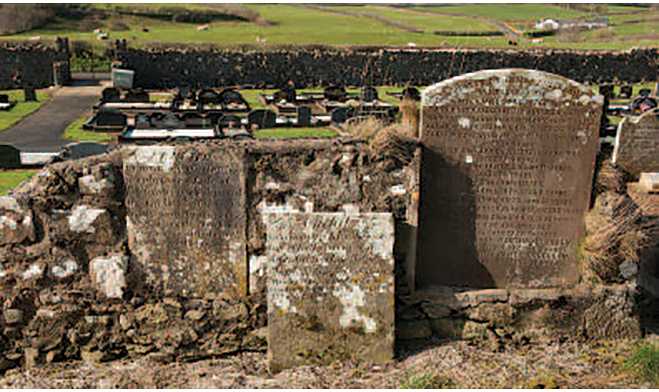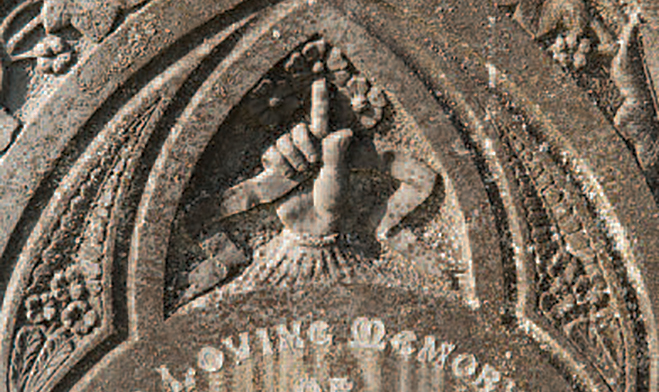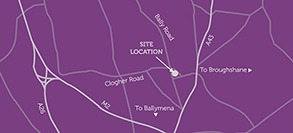Pre-Reformation Trail
Kirkinriola
It appears probable that on the site a much older church once stood.
Access details
The churchyard is located approximately 3 miles from Ballymena, and is best accessed from the Bally Road where there is space for parking.RPC
Grid Reference
The church
The present ruined church of Kirkinriola (or Kilconriola as it is also known) may have replaced a much earlier church on this site. In 1622 the parish church was decayed and by 1657 it was out of repair. By 1658, alternative arrangements for public worship were made by the rebuilding of a preaching house at Ballymena. There are burials and gravestones inside the church whilst some gravestones have been built into the east gable.
The carved stone and bell
In 1868, an carved basalt stone was discovered in the graveyard. It featured a carving of a Celtic cross with the words Ort do Degen (a prayer for Degen). The stone is now located in the interior porch wall of St Patrick's Church in Ballymena. The name ‘Degen’ is thought to refer to an early Irish bishop, Degan, who died in AD 639. In 1870, a large bronze bell was discovered in the Kirkinriola parish. The bell is thought to date from the 900s and indicates early Christian monastic settlement in the area. On loan from the National Museums Northern Ireland, it is on display in Mid-Antrim Museum, Ballymena.
The graveyard
In the 1880s a souterrain (man-made underground chamber) was found in the graveyard. It consisted of three chambers, one of which may have led to the early church. It cannot now be traced. The graveyard contains memorials of several prominent local families. The earliest gravestone bears the date 1710. It was found when digging the burial ground wall of the Raphael family. It is now set into the wall of the Raphael monument.
The Raphael monument
The largest monument commemorates members of the Raphael family of Galgorm. The inscription on the monument commemorates amongst others, James Raphael. He was 'shot in Ballymena during the Irish Rebellion, 1798'. Local tradition has it that he tried to defend the market house in Ballymena when it came under siege by a band of United Irishmen.
Orr family
There is a memorial commemorating William Orr, from Creavery, near Antrim who died in 1860 aged 86. He was a United Irishman and was at Randalstown during the 1798 Rebellion. He was transported to Australia the following year but eventually returned to Ireland, settling near Ballymena.
Dickey family
A gravestone commemorates Andrew Todd Dickey. He was the grandson of Thomas Dickey who had connections with the linen works at Leighinmohr. Thomas built a house which resides within the current grounds of St Louis' Gammar School, Ballymena. Although now derelict, the school have recently been awarded a grant to restore the old house.
Eaton family
A gravestone commemorates several members of the Eaton family descended from John and Margaret Eaton. They had several sons who emigrated to Canada. Their son Timothy, who emigrated in 1854, established Eaton’s, a highly successful and innovative chain of department stores. He is remembered for his substantial charitable contributions in Toronto and locally, for Eaton Park, Ballymena. The Eaton homestead is a listed building at about a mile from the cemetery. It is in private ownership and not accessible but Timothy's achievements are celebrated by an Ulster History Circle Blue Plaque on the building.
| Churchyard Facts & Figures | |
| First used as a Christian religious site | First reference 1584, though Archaeological finds suggest Early Christian Period (500-1100AD) |
| Papal taxation of c.1300 | None listed - Kirkinriola was possibly assessed with Muckamore or Ahoghill |
| Church size | Medieval church - 61 feet by 21.5 feet |
| Discontinued use of church | c.1657 |
| Townland | Kirkinriola |




